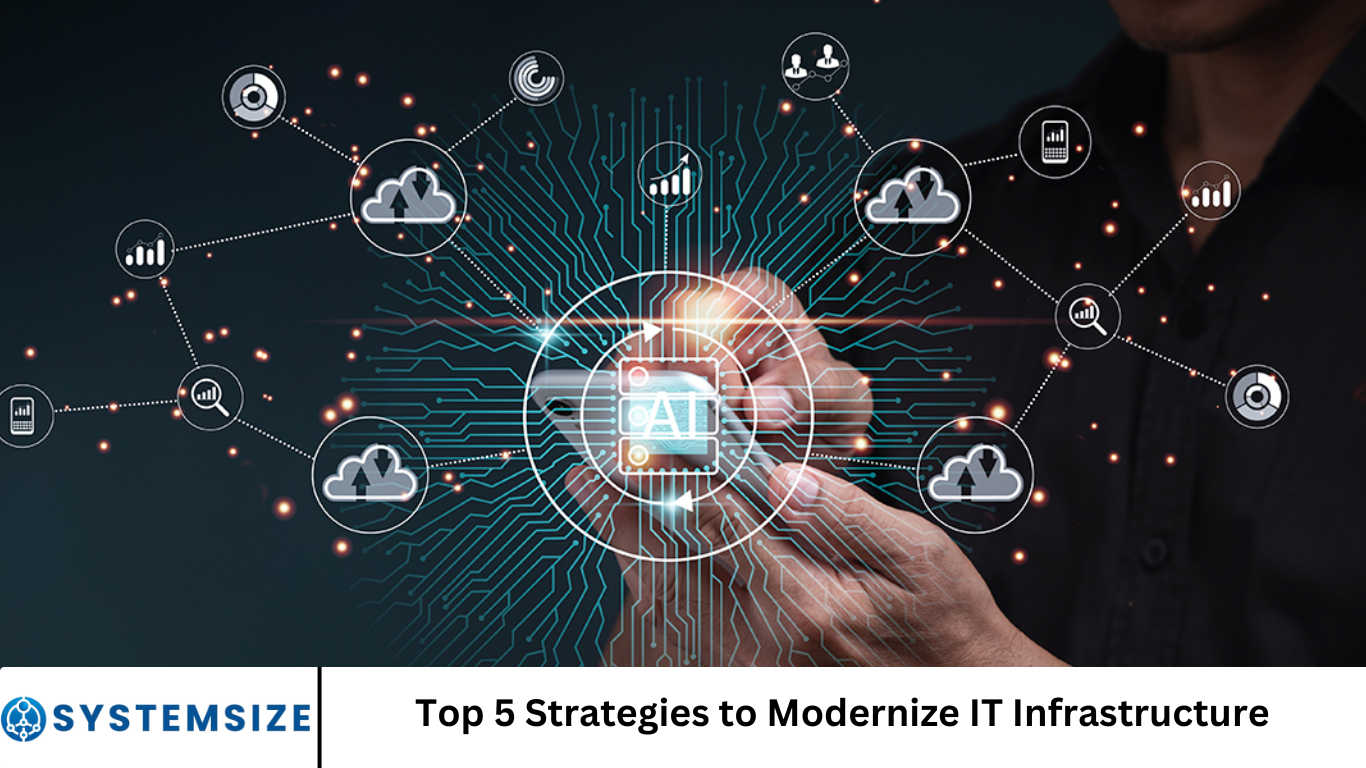Modern IT infrastructure is the backbone of any successful organization. As the digital landscape evolves, companies must adopt robust strategies to modernize their IT environments, enhance operational agility, and drive business innovation.
According to recent studies, 94% of C-suite executives agree that outdated infrastructure impedes innovation and agility. As technology advances, staying ahead requires a proactive, strategic approach to IT modernization.
This article outlines the top five strategies to modernize IT infrastructure, helping organizations remain competitive, scalable, and secure in a constantly changing digital world.
More Read: Top Data Management Solutions for 2025
1. Embrace Cloud Computing
One of the most transformative steps in IT modernization is migrating to the cloud. Cloud computing offers scalability, flexibility, and cost-effectiveness that traditional on-premises systems can’t match.
Benefits of Cloud Adoption:
- Scalability: Scale resources up or down based on demand.
- Cost Savings: Pay-as-you-go models reduce capital expenditures.
- Accessibility: Employees can access systems and data from anywhere.
- Disaster Recovery: Enhanced data backup and recovery options.
Types of Cloud Models:
- Public Cloud (e.g., AWS, Microsoft Azure, Google Cloud)
- Private Cloud (dedicated environments for specific organizations)
- Hybrid Cloud (combination of public and private models)
Best Practices for Cloud Migration:
- Conduct a thorough readiness assessment
- Prioritize applications based on business impact
- Ensure compliance and security protocols are in place
- Train staff for cloud-based operations
Embracing cloud technologies not only modernizes infrastructure but also enables faster innovation and improved user experiences.
2. Implement IT Infrastructure Automation
Infrastructure automation is key to improving efficiency, reducing human error, and speeding up service delivery. Automation tools help streamline repetitive tasks such as software deployments, configuration management, and patch updates.
Key Automation Tools:
- Ansible: Open-source tool for configuration management
- Terraform: Infrastructure as code (IaC) tool for managing resources
- Puppet & Chef: Automate provisioning and configuration
Advantages of IT Automation:
- Improved Consistency: Eliminates manual errors
- Faster Deployments: Enables continuous integration and delivery (CI/CD)
- Resource Optimization: Frees up IT teams for strategic tasks
Automation Strategy Tips:
- Start with high-impact, repetitive tasks
- Use version control for automation scripts
- Monitor and audit automated processes regularly
By automating IT operations, organizations can significantly improve infrastructure management and focus on innovation.
3. Adopt a Zero Trust Security Model
Security is a critical aspect of modern IT infrastructure. With increasing cyber threats and remote work becoming the norm, a Zero Trust Architecture (ZTA) ensures that no one is trusted by default—whether inside or outside the network.
Core Principles of Zero Trust:
- Verify Every Access Request: Authenticate and authorize every access
- Least Privilege Access: Grant users the minimum level of access needed
- Micro-Segmentation: Divide the network into smaller zones for better control
Implementation Steps:
- Identify sensitive data and assets
- Deploy multi-factor authentication (MFA)
- Continuously monitor network activity
- Use endpoint detection and response (EDR) tools
Benefits of Zero Trust:
- Minimizes the attack surface
- Enhances compliance with data protection regulations
- Increases visibility and control over user activities
A Zero Trust model builds resilience into your IT infrastructure and ensures a strong security posture.
4. Optimize IT Asset Lifecycle Management
Managing the IT asset lifecycle—from procurement to decommissioning—is crucial for maintaining infrastructure health and cost-efficiency. Organizations must track and optimize hardware and software assets to avoid inefficiencies and security risks.
Lifecycle Management Phases:
- Planning: Identify needs and budget
- Procurement: Acquire assets based on requirements
- Deployment: Install and configure assets
- Maintenance: Monitor performance and apply updates
- Disposal: Securely decommission outdated assets
Tools for Asset Management:
- ServiceNow ITAM
- Ivanti IT Asset Manager
- Freshservice
Best Practices:
- Maintain an accurate inventory of all assets
- Regularly audit asset usage and performance
- Automate license renewals and updates
- Implement secure disposal methods
By optimizing IT asset management, businesses can ensure infrastructure reliability and reduce operational costs.
5. Leverage Data Analytics and AI for Predictive Insights
Modern IT infrastructure generates massive volumes of data. Harnessing this data through analytics and artificial intelligence (AI) can lead to better decision-making, proactive maintenance, and enhanced service delivery.
Key Use Cases:
- Predictive Maintenance: Identify and resolve issues before they cause downtime
- Capacity Planning: Forecast future infrastructure needs
- Security Monitoring: Detect anomalies and prevent breaches
Popular Tools:
- Splunk: Real-time data analysis and monitoring
- Datadog: Infrastructure monitoring and observability
- IBM Watson: AI-driven insights and automation
Steps to Implement Analytics:
- Centralize data collection from all infrastructure components
- Use machine learning models to analyze trends
- Integrate insights into IT operations and planning
By leveraging AI and data analytics, organizations can transform raw data into actionable intelligence, leading to smarter infrastructure management.
Frequently Asked Question
Why is modernizing IT infrastructure important for businesses today?
Modernizing IT infrastructure enhances agility, improves security, reduces operational costs, and supports digital transformation initiatives. With legacy systems limiting innovation and scalability, modernization enables businesses to stay competitive in a rapidly evolving digital landscape.
What are the main benefits of moving to cloud computing?
Cloud computing provides flexibility, scalability, and cost-efficiency. It allows businesses to scale resources on demand, supports remote access, improves disaster recovery, and reduces the need for costly on-premises hardware.
How does IT automation improve infrastructure management?
IT automation streamlines repetitive tasks, reduces human error, accelerates deployment times, and ensures consistency. It frees up IT teams to focus on strategic projects while improving service delivery and reliability.
What is Zero Trust Security, and why is it essential?
Zero Trust Security is a framework that assumes no user or system is trusted by default, even within the network. It enhances cybersecurity by verifying all access requests, enforcing least-privilege access, and segmenting the network to reduce attack surfaces.
How can organizations manage IT asset lifecycles effectively?
Effective IT asset lifecycle management involves planning, procurement, deployment, maintenance, and secure disposal of hardware and software. Using tools like ServiceNow or Ivanti, organizations can automate tracking, optimize costs, and ensure compliance.
What role does AI and data analytics play in IT infrastructure modernization?
AI and analytics provide predictive insights that help with proactive maintenance, capacity planning, and threat detection. By analyzing infrastructure data, businesses can make informed decisions and optimize performance.
How should a company begin its IT modernization journey?
Start by assessing current infrastructure and identifying pain points. Prioritize initiatives like cloud adoption or automation that align with business goals. Establish a roadmap, ensure stakeholder buy-in, and adopt a phased implementation strategy for long-term success.
Conclusion
Modernizing IT infrastructure is no longer optional—it’s a strategic necessity. Organizations that adopt cloud computing, automate infrastructure, enforce Zero Trust security, manage IT assets effectively, and use data-driven insights will be well-positioned for future success. Each of these five strategies plays a vital role in creating an agile, scalable, and secure IT environment. By embracing these approaches, businesses can drive innovation, enhance service delivery, and stay ahead in a competitive digital economy.


